M1L6 DNA replication defects
1/24
There's no tags or description
Looks like no tags are added yet.
Name | Mastery | Learn | Test | Matching | Spaced |
|---|
No study sessions yet.
25 Terms
DNA-protein crosslinks (DPCs)
DPCs are a result of covalent attachment of proteins to DNA (high probability due to large number of proteins associated with DNA - histones, replicative enzymes, transcription factors, DDR proteins etc…)
Which nucleotides are the strongest crosslinkers?
Guanine and lysine
Why are histone tails prone to attach to DNA?
There are many lysine (strong crosslinkers) residues in histone tails, making them prone to attach to guanines in DNA
What is a major inducer of DPCs?
Formaldehyde is a major inducer of DPCs, as well as chemotherapy drugs (eg. topoisomerase inhibitors, cisplatin…)
What are the two types of DPC formation?
Non-enzymatic: formaldehyde and methanol
Aldehydes (formaldehyde, acetaldehyde) can form covalent bonds between amino acid residues and DNA bases
UV or IR can also cross link nearby proteins to DNA
Endogenous metabolism can product reactive aldehydes and lipid peroxidation byproducts that contribute to this
Enzymatic: lesions caused by topoisomerase, DNA polymerase β etc enzymes

How can DPCs marked for degradation?
Ubiquitination and SUMOylation mark DPCs for degradation
DPCs can be resolved through proteolysis or HR if fork collapse leads to DSBs or if there are DSBs resulting from topoisomerase activity
Proteolysis is carried out by the proteasome and SPRTN protease which degrade protein adducts
After partial proteolysis repair is completed by TLS polymerases which bypass the remaining peptide adducts and NER to remove residual protein fragments
Explain how ubiquitination coordinates temporal regulation of proteins at DNA damage sites
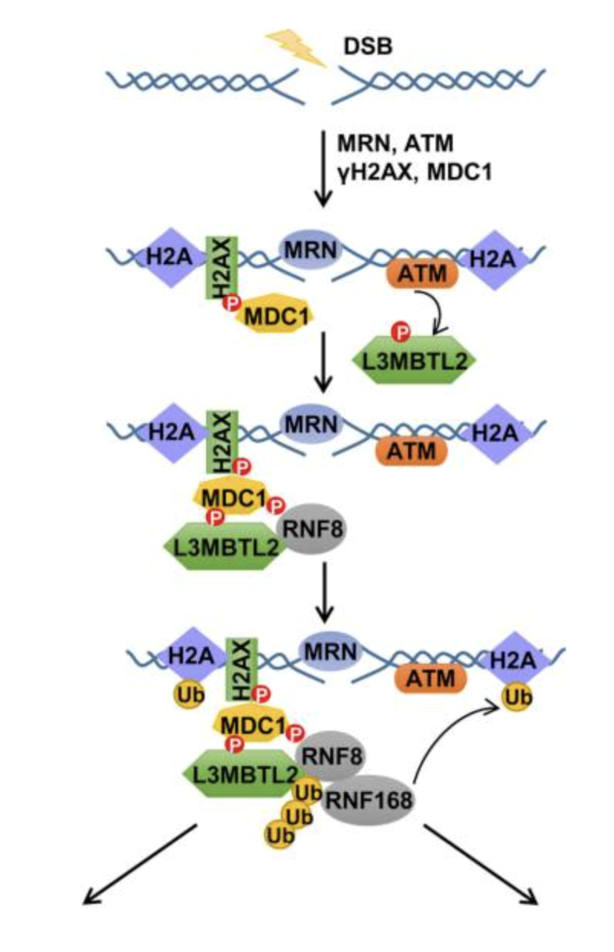
MRN detects the DSB and recruits/activates ATM kinase
ATM phosphorylates H2AX near the break
MDC1 binds to γH2AX, stabilising the repair focus
ATM phosphorylates L2MCTL2 which interacts with MDC1 and RNF8 (an E3 ubiquitin ligase)
RNF8 ubiquitinates histones and other local proteins
RNF8-generated ubiquitin chains recruits RNF168 which amplifies ubiquitin signalling my spreading ubiquitin marks on chromatin
Ubiquitin marks act as docking sites for repair proteins like 53BP1 (for NHEJ) or BRCA1 (for HR)
Explain NHEJ downstream of ubiquitin-mediated DPC repair
53BP1 binds to ubiquitylated H2A/H4
HR is blocked as 53BP1 and KEAP1 inhibits BRCA1 recruitment
PTIP FIF1, shieldin complex, CST–Polα–Primase, and Artemis assemble, processing and ligating DNA ends directly
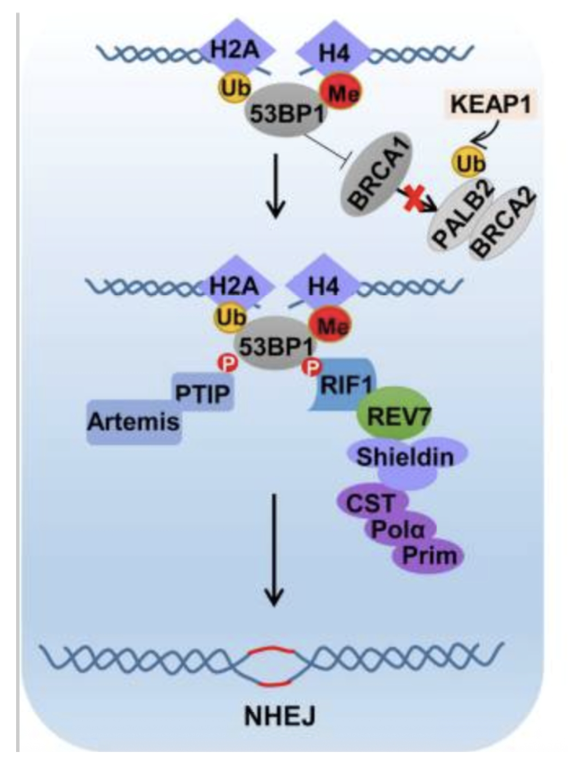
Explain HR downstream of ubiquitin-mediated DPC repair
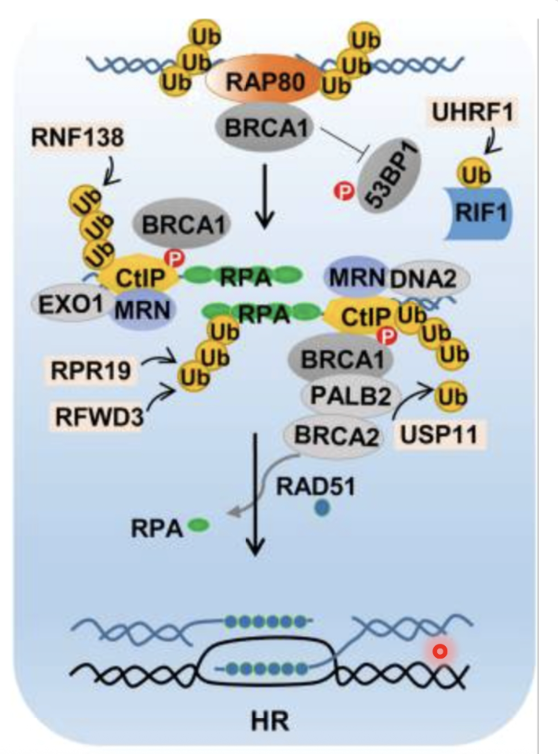
BRCA1 is recruited by RAP80, RNF8/RNF168
BRCA1 antagonises 53BP1 and promotes end resection for HR
MRN, CtIP, EXO1 and DNA2 create 3’ ssDNA overhangs
RPA coats ssDNA and BRCA1/PALB2/BRCA1 load RAD51. forming the nucleoprotein filament
RAD51 filament searches for homologous DNA template and promotes strand invasion and HR repair
What is the role of p97 in chromatin associated degradation (CHROMAD)?
p97 (aka VCP) is an ATPase in the ubiquitin system which recognises ubiquitinated substrates and uses cofactors with specificity to the substrate to bind and hydrolyse ATP and thereby extract substrates from chromatin
p97 is a homohexamer and physically extracts substrates through its central pore
How are cofactors of p97 implicated in human disease?
Ataxin-3 (mutated in ataxia/Machado-Joseph disease) which works with p97 to remove proteins by the proteasome, specifically RNF8
SPRTN (mutated in Ruijs-Aalfs Syndrome - premature ageing) - important for removing DPCs
TEX264 (colorectal cancer)
How does formaldehyde enter or get generated in the body?
Formaldehyde can be from smoke, industrialisation, environmental stressors but also a product of endogenous metabolism:
Synthesis of some amino acids or nucleic acids
Methyl groups removed by demethylases can produce formaldehyde in the presence of oxygen
Mitochondrial stress causes lipid peroxidation in its double lipid membrane, producing formaldehyde
What are the two tiers of protection from aldehyde (acetaldehyde and formaldehyde) toxicity
Detoxifying enzymes - aldehyde and alcohol dehydrogenases
DNA repair (DPCs)
Describe ethanol metabolism
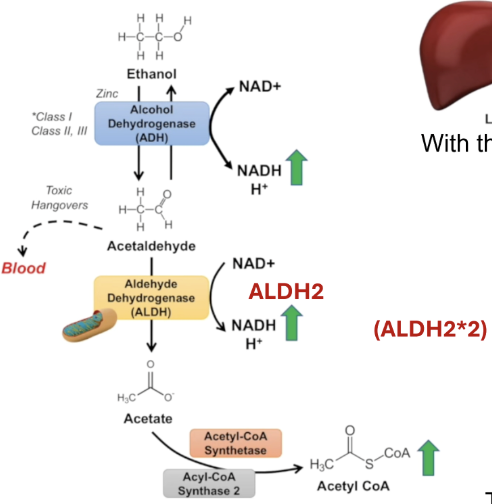
Alcohol dehydrogenase converts ethanol to acetaldehyde (toxic) by using NAD+ which gets converted to NADH + H+
Acetaldehyde is converted to acetate by aldehyde dehydrogenase using NAD+ which gets converted to NADH + H+
Acetate is converted to acetyl CoA by acetyl CoA synthetase 2
Describe methanol metabolism
Methanol metabolism - methanol can come from consuming cheap alcohol (methanol mixed with ethanol) or even from your own microbiome via fermentation processes
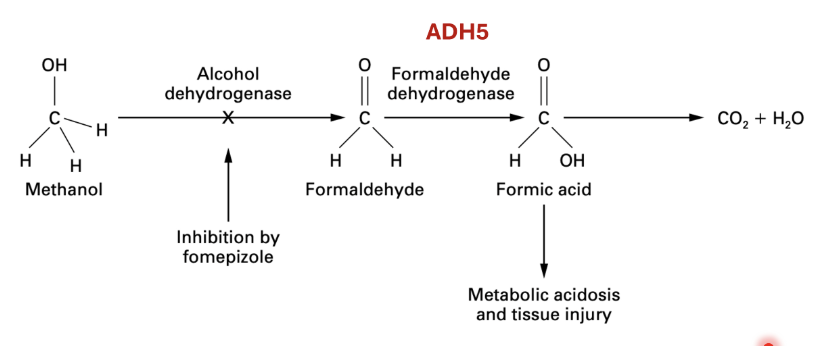
Methanol converted to formaldehyde by alcohol dehydrogenase (very toxic)
Formaldehyde converted to formic acid by formaldehyde dehydrogenase —> metabolic acidosis + tissue injury
Inhibiting ADH5 can lead to high levels of formaldehyde toxicity
Formic acid converted to CO2 + H2O
What human diseases are caused by DPCs?
AMeD syndrome (aplastic anaemia, intellectual disability, dwarfism) - digenic mutations in ALDH2 (SNP; on one allele) and ADH5 (biallelic mutations)
Ruijs-Aalfs syndrome - monogenic cause (biallelic mutations in SPRTN)
Cockayne syndrome - defect TC-NER, monogenic and biallelic mutations in CSA or CSB
Describe the role of SPRTN in DPC repair and fork progression
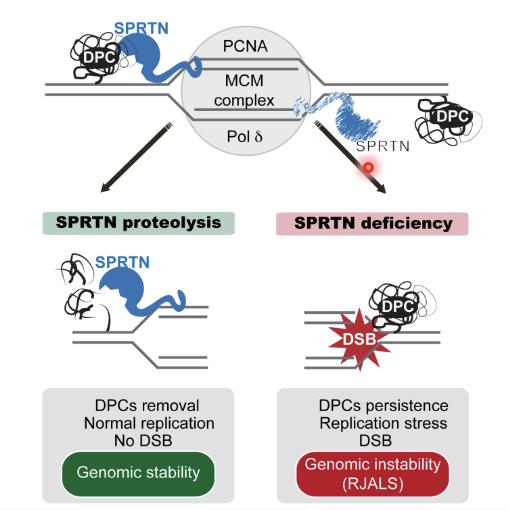
Cleaves a variety of DNA binding substrates (eg histones) and also itself
Cleaves free and covalently attached Top1 and Top2
Defects in SPRTN characterised by RJALS and liver cancer
Describe the role of the p97-SPRTN-TEX264 complex in resolvin g Top1ccs
TEX264 is one of the main receptors for autophagy during starvation and it also plays a major role in DPC repair by acting as a p97 adaptor protein
p97-SPRTN-TEX264 can recognise DPC lesion (eg. Topo1cc or Topoisomerase 1-cleavage complexes which is an enzymatic DPC) on DNA
TEX264 recruits p97/SPRTN to the DPC and SPRTN proteolytically degrades the protein adduct while p97 proides unfolding and extraction energy to clear the protein remnants from chromatin
After DPC processing DNA can be repaired by DDR mechanisms
TEX264 also acts as an ER-resident autophagy receptor where it interacts with LC3 on phagophores for ER-phagy
Explain transition coupled NER

CSB binds to stalled RNA pol II and recruits CSA (E3 ubiquitin ligase) and other repair factors, remodeling RNA pol II and forming the damage recognition complex that distinguishes transcription blocking lesions
TFIIH recruited to the site which containes the helicases XPB and XPD to unwind local DNA
XPG (endonuclease) and other XP proteins (XPA, XPB, DPD) join to form the NER core complex
SPG and XPF-ERCC1 make dual incisions flanking the lesion and the damaged oligonucleotide is excised
RPA and XPA stabilise the single stranded region\
XPA is also an E3 ubiquitin ligase which ubiquitinates TC-NER proteins like CSB and TFIIH to regulate their recruitment, retention or release at the lesion site
The gap is filled by DNA pol using the undamaged strand as a template and the nick is sealed by DNA ligase
After repair XPA and othe ligases promote proteasomal clearance of excess or damaged repair factors to prevent persistent stalling
Explain transition coupled DPC repair
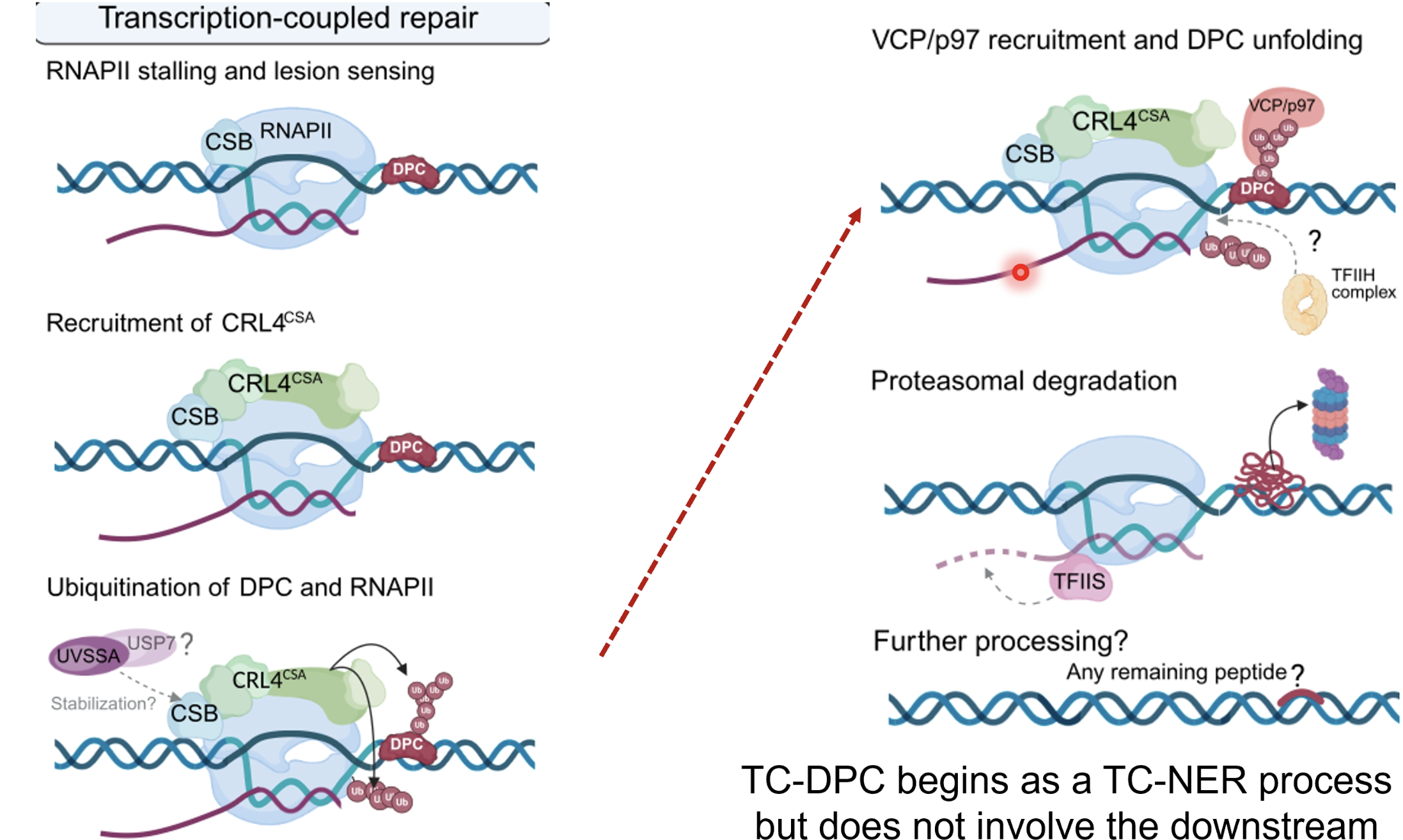
TC-DPC repair begins as a TC-NER process
RNA pol II stalls at DPC and CSB binds and recruits CRLRCSA ubiquitin ligase complex which ubiquitinates the DPC to mark it for degradation and also RNA pol II to mark it to be removed or recycled after the lesion is repaired
p97 ATPase unfoldase is recruited to extract/unfold the ubiquitylated DPC protein from DNA
TFIIH likely facilitates or stabiilises p97 recruitment and activity but is not essential for unfolding itself, rather helps remodel RNAPII-DNA-DPC complex to improve access for p97
DPC protein is then degraded by the proteasome
TFIIS (transcription elongation factor) helps restart or rescue RNAPII
Remaining peptide adducts could be handled by SPRTN (like in RC-DPC repair)
What is the key players of the parallel DPC repair pathway?
RC-DPC (SPRTN) -replication coupled
TC/DPC (CSA/CSB) - transcription coupled
Both converge on p97 (VPC)
Explain the selective autophagy (nucleophagy) of Top1cc

May explain why many cancers upregulate autophagy
Part of the DPC lesion which can not be removed by SPRTN are becoming insoluble and forming aggregates
In this case, TEX264 removes the lesion and shuttles it to the lysosome for degradation
When there are DPCs autophagy proteins and lysosomes can be recruited to the replication fork even from outside the nucleus
There is interorganelle communication - replication fork recruits lysosomes and lysosomes can also recruit replication proteins
How can TEX264 indicate responsiveness to Topo inhibitors?
TEX264 expression can be an predictor of responsiveness to Topo inhibitors (higher expression = better responders)
How is cytotoxic trapped PARP1 removed>
Nucleophagy can also remove cytotoxic trapped PARP1
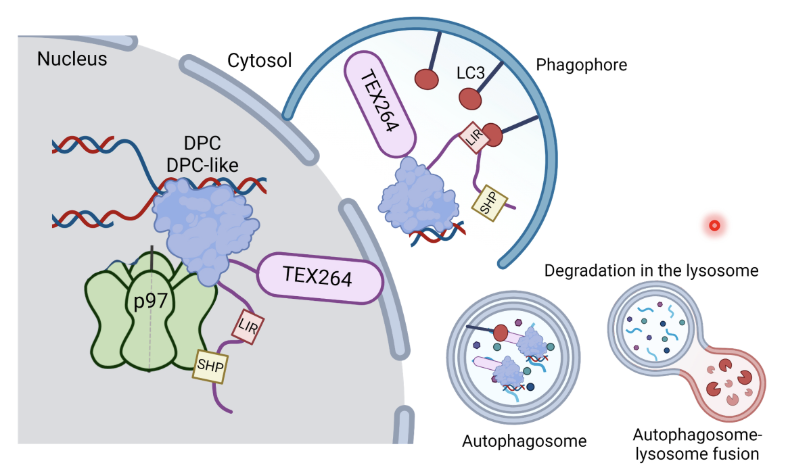
How can TEX264 be implicated in resensitising PARPi resistant breast cancer cells?
Inactivation of TEX264-selective autophagy resensitises BRCA-deficient cells that have acquired resistance to PARPi